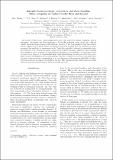| dc.contributor.author | Fardin, Marc-Antoine | |
| dc.contributor.author | Grenard, V. | |
| dc.contributor.author | Divoux, T. | |
| dc.contributor.author | Manneville, S. | |
| dc.contributor.author | Lerouge, S. | |
| dc.contributor.author | Ober, Thomas Joseph | |
| dc.contributor.author | McKinley, Gareth H. | |
| dc.date.accessioned | 2013-09-23T15:58:30Z | |
| dc.date.available | 2013-09-23T15:58:30Z | |
| dc.date.issued | 2012-08 | |
| dc.date.submitted | 2012-06 | |
| dc.identifier.issn | 1744-683X | |
| dc.identifier.issn | 1744-6848 | |
| dc.identifier.uri | http://hdl.handle.net/1721.1/80865 | |
| dc.description.abstract | In the past twenty years, shear-banding flows have been probed by various techniques, such as rheometry, velocimetry and flow birefringence. In micellar solutions, many of the data collected exhibit unexplained spatiotemporal fluctuations. Recently, it has been suggested that those fluctuations originate from a purely elastic instability of the shear-banding flow. In cylindrical Couette geometry, the instability is reminiscent of the Taylor-like instability observed in viscoelastic polymer solutions. The criterion for purely elastic Taylor–Couette instability adapted to shear-banding flows suggested three categories of shear-banding depending on their stability. In the present study, we report on a large set of experimental data which demonstrates the existence of the three categories of shear-banding flows in various surfactant solutions. Consistent with theoretical predictions, increases in the surfactant concentration or in the curvature of the geometry destabilize the flow, whereas an increase in temperature stabilizes the flow. However, experiments also exhibit some interesting behaviors going beyond the purely elastic instability criterion. | en_US |
| dc.description.sponsorship | National Science Foundation (U.S.). Graduate Research Fellowship Program | en_US |
| dc.language.iso | en_US | |
| dc.publisher | Royal Society of Chemistry, The | en_US |
| dc.relation.isversionof | http://dx.doi.org/10.1039/c2sm26313k | en_US |
| dc.rights | Creative Commons Attribution-Noncommercial-Share Alike 3.0 | en_US |
| dc.rights.uri | http://creativecommons.org/licenses/by-nc-sa/3.0/ | en_US |
| dc.source | MIT web domain | en_US |
| dc.title | Interplay between elastic instabilities and shear-banding: three categories of Taylor–Couette flows and beyond | en_US |
| dc.type | Article | en_US |
| dc.identifier.citation | Fardin, M. A., T. J. Ober, V. Grenard, T. Divoux, S. Manneville, G. H. McKinley, and S. Lerouge. “Interplay between elastic instabilities and shear-banding: three categories of Taylor–Couette flows and beyond.” Soft Matter 8, no. 39 (2012): 10072. | en_US |
| dc.contributor.department | Massachusetts Institute of Technology. Department of Mechanical Engineering | en_US |
| dc.contributor.mitauthor | Ober, Thomas Joseph | en_US |
| dc.contributor.mitauthor | McKinley, Gareth H. | en_US |
| dc.contributor.mitauthor | Fardin, Marc-Antoine | en_US |
| dc.relation.journal | Soft Matter | en_US |
| dc.eprint.version | Author's final manuscript | en_US |
| dc.type.uri | http://purl.org/eprint/type/JournalArticle | en_US |
| eprint.status | http://purl.org/eprint/status/PeerReviewed | en_US |
| dspace.orderedauthors | Fardin, M. A.; Ober, T. J.; Grenard, V.; Divoux, T.; Manneville, S.; McKinley, G. H.; Lerouge, S. | en_US |
| dc.identifier.orcid | https://orcid.org/0000-0001-8323-2779 | |
| dspace.mitauthor.error | true | |
| mit.license | OPEN_ACCESS_POLICY | en_US |
| mit.metadata.status | Complete | |
